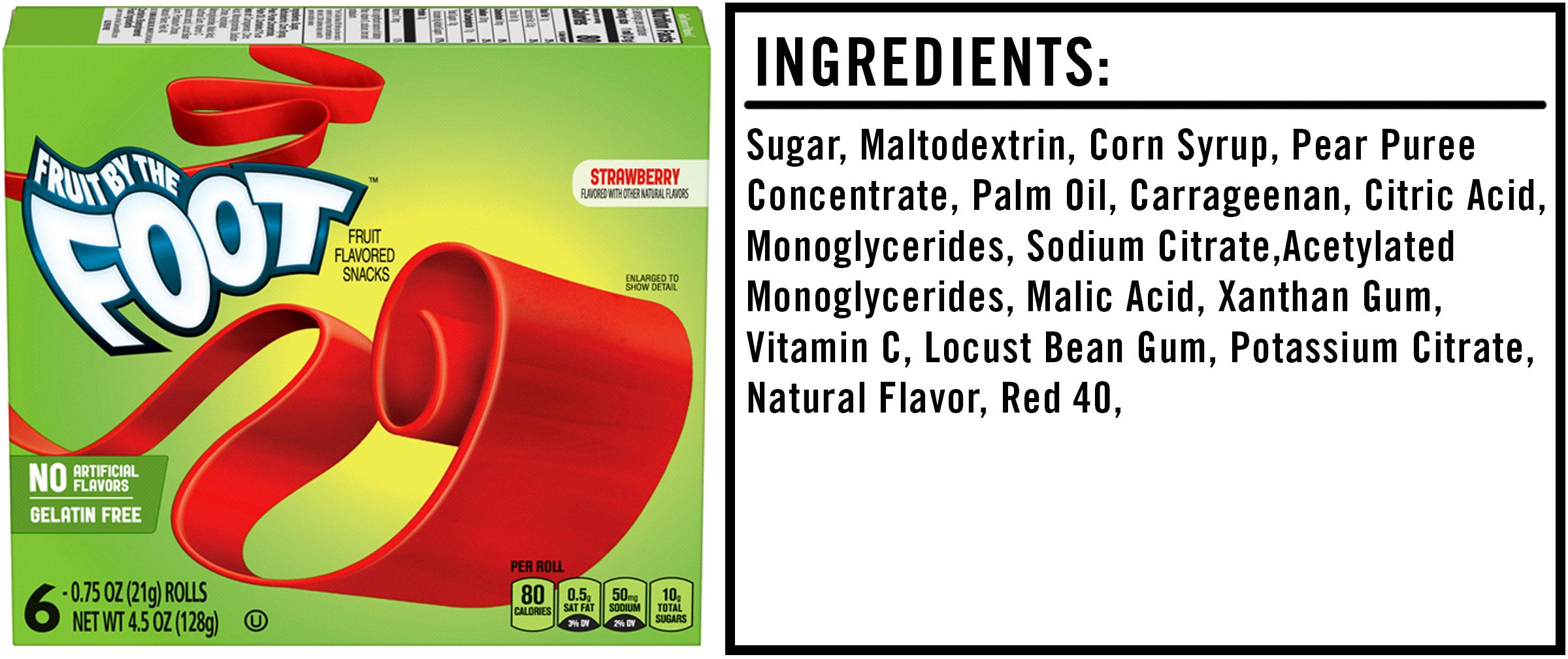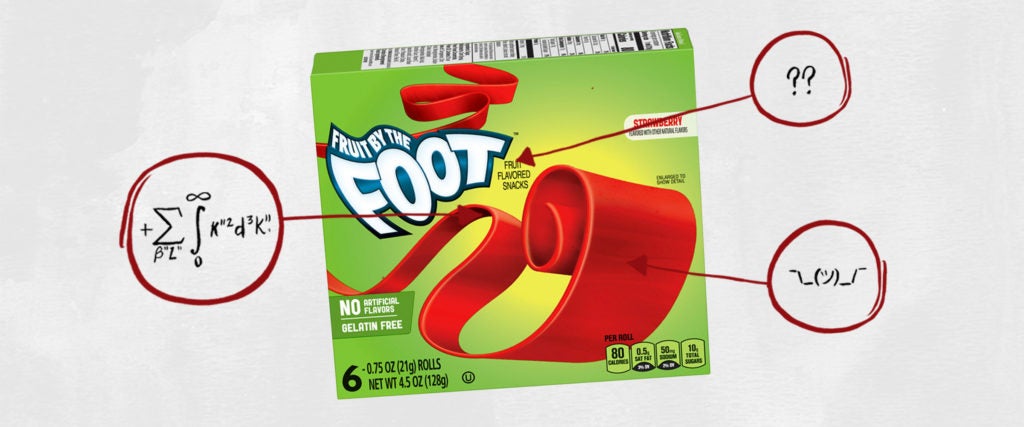We’re often told that you should never eat anything (or put anything on your body) if you don’t recognize everything on the ingredients list. But since most of us have no idea what xanthan gum or potassium benzoate are — or more importantly, what they’re doing to our bodies — we’re decoding the ingredients in the many things Americans put in (and on, or near) themselves.
This edition: Fruit by the Foot (Strawberry), which are made from 17 separate ingredients that we’ve broken down as they appear online.
- Read Next: What’s in This?: Mountain Dew

The Ingredients
1) Sugar: A single Fruit by the Foot has 10 grams of sugar, which is a considerable load for such a small snack. For reference, the American Heart Association recommends men consume no more than 36 grams and women consume no more than 25 grams of added sugar a day.
2) Maltodextrin: An artificial sugar made from maltose (aka malt sugar) and dextrose (a sugar derived from starches), maltodextrin is usually used as a thickener or filler ingredient to add bulk to processed food and to increase its shelf life. (Maltodextrin itself has a shelf life of two years.)
3) Corn Syrup: Corn syrup is a liquid sweetener made of glucose (aka sugar). It might as well be liquid sugar, unhealthiness and all.
4) Pear Puree Concentrate: This is supposed to be a strawberry-flavored Fruit by the Foot, but what the hell: Condensed pear for flavoring.
5) Palm Oil: This keeps your Fruit by the Foot from drying out. Unfortunately, according to physician and biochemist Cate Shanahan, consuming too much vegetable oil — which is easy to do, considering Shanahan says roughly 45 percent of the average American’s calories come from refined oils — has serious repercussions (e.g., fatty liver disease, insulin resistance and migraines). Plus, of all the vegetable oils out there, palm oil in particular is awful for the environment.
6) Carrageenan: This is widely used in the food industry for its gelling, thickening and stabilizing properties. Some animal studies argue that there’s a connection between carrageenan ingestion and inflammatory bowel disease; however, the FDA lists the ingredient as “generally recognized as safe.” And more recent human studies take the FDA’s side on this one.
7) Citric Acid: Citric acid naturally occurs in citrus fruits and is often added to foods to extend their shelf life. In higher amounts, it also tastes sour.
8) Monoglycerides: Monoglycerides are a type of fat that prevent water and oil from separating, making them common additives in processed foods. The FDA classifies monoglycerides as “generally recognized as safe,” and most producers add them in small amounts, anyway.
The one problem with monoglycerides is that they can contain trans fats that aren’t listed on the nutrition label, and because trans fats are associated with an increased risk of heart disease, stroke and diabetes, consuming more than you think you are could do serious damage to your body.
9) Sodium Citrate: Sodium citrate is the sodium salt of citric acid. It acts as a preservative and can provide a sour taste when added in high amounts.
10) Acetylated Monoglycerides: Acetylated monoglycerides serve more or less the same purpose as regular monoglycerides: They improve the texture by helping other ingredients mesh together.
11) Malic Acid: Malic acid occurs naturally in many fruits and vegetables, and it acts as a source of tartness in all kinds of sour candy.
12) Xanthan Gum: Xanthan gum is a relatively harmless thickening agent. That said, those with bowel issues should be wary when consuming it, as a study found it to be a highly efficient laxative.
13) Vitamin C (Ascorbic Acid): In addition to providing some nutrition — something that might help Fruit by the Foot appear to be a slightly less unhealthy snack — vitamin C can also be used as a preservative.
14) Locust Bean Gum: Locust bean gum is a natural food additive derived from carob seeds. It’s used primarily as a thickening and stabilizing agent.
15) Potassium Citrate: This is a potassium supplement, and increasing your potassium intake can help lower your blood pressure and protect against muscle cramping, according to Harvard Medical School. In some cases, potassium citrate can also help stabilize foods and regulate their acidity levels, which is probably the real reason why it’s in Fruit by the Foot.
16) Natural Flavor: It’s hard to say what exactly this natural flavor is (although, my guess is strawberry), but more generally, natural flavors are flavors derived from an actual food source — i.e., strawberry flavoring taken from a real strawberry.
17) Red 40: Like many artificial colors, red 40 is known to be carcinogenic. However, as Shanahan explained during my analysis of Doritos, studies claiming this often use unreasonable amounts of artificial colors in their experimentation, so fret not.
The Takeaway
As is often the case, the worst thing about a Fruit by the Foot is the fact that it puts you about a third of the way toward your daily recommended sugar intake. The palm oil isn’t great either, and monoglycerides are worth avoiding if you can, but sugar is your biggest enemy here.
Maybe try a real strawberry instead.

